Investigating Factors That Influence Entrepreneurial Firm Performance
VerifiedAdded on 2022/05/09
|11
|3163
|29
Report
AI Summary
This report examines the factors that influence the performance of entrepreneurial firms, drawing on various research studies. It explores how knowledge-based paradigms and innovation contribute to new ventures and economic structures. The report analyzes internal and external factors affecting small-scale firms, including entrepreneur characteristics, firm attributes, and institutional support. It highlights the importance of social norms, performance-based cultures, external collaborations, and dynamic capabilities. The report also discusses the impact of entrepreneur's age, education, and access to financial and technical resources on firm development, using data from various regions and industries. The analysis includes a focus on innovation, human resources, and sustainable business models, aiming to provide a comprehensive understanding of the key drivers for entrepreneurial success. The report also includes the methodology used by researchers to study the factors affecting the performance of small and medium enterprises (SMEs).
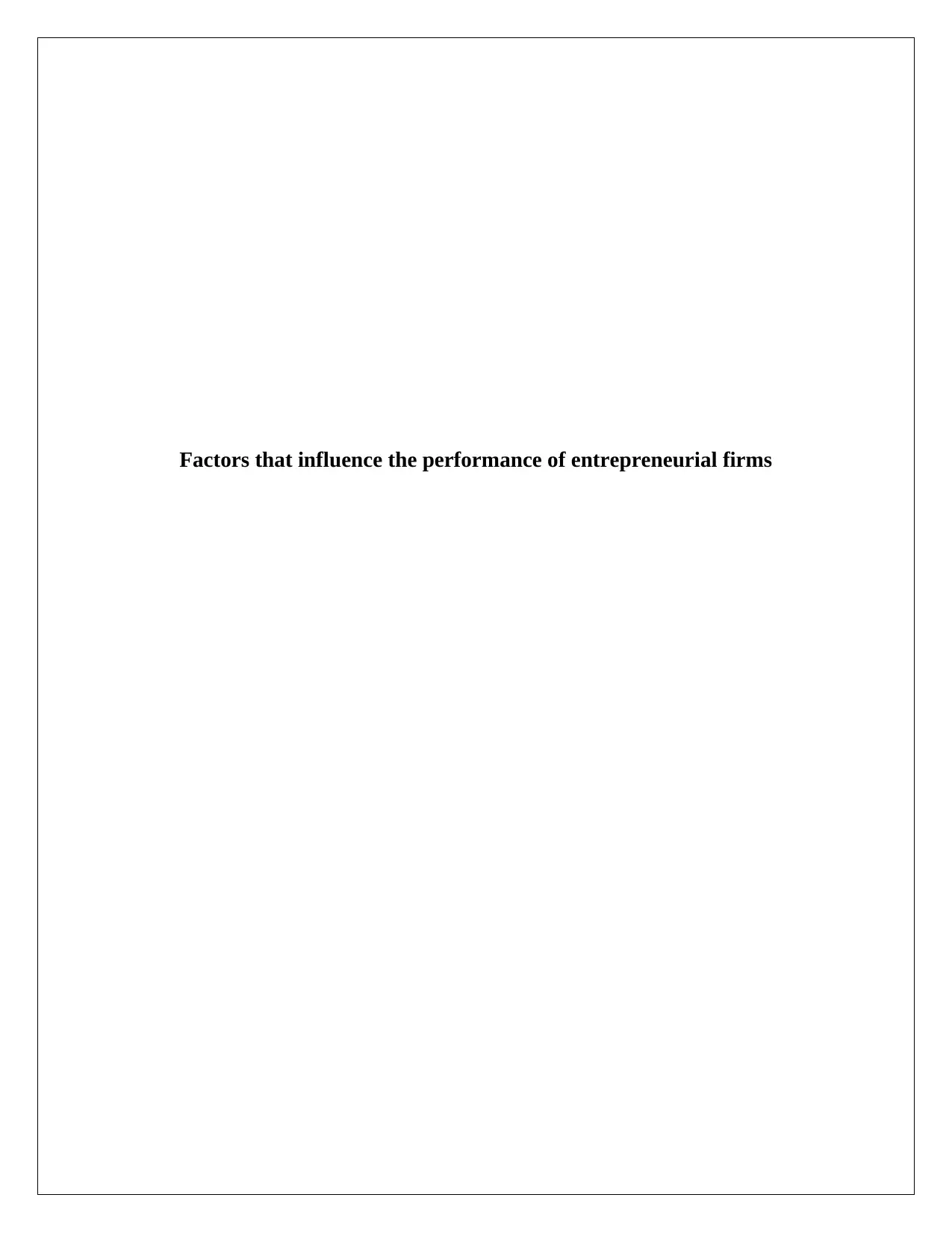
Factors that influence the performance of entrepreneurial firms
Paraphrase This Document
Need a fresh take? Get an instant paraphrase of this document with our AI Paraphraser

Contents
Introduction.............................................................................................................................................................. 3
Main Body.................................................................................................................................................................. 4
Conclusion................................................................................................................................................................. 9
References............................................................................................................................................................... 10
Introduction.............................................................................................................................................................. 3
Main Body.................................................................................................................................................................. 4
Conclusion................................................................................................................................................................. 9
References............................................................................................................................................................... 10
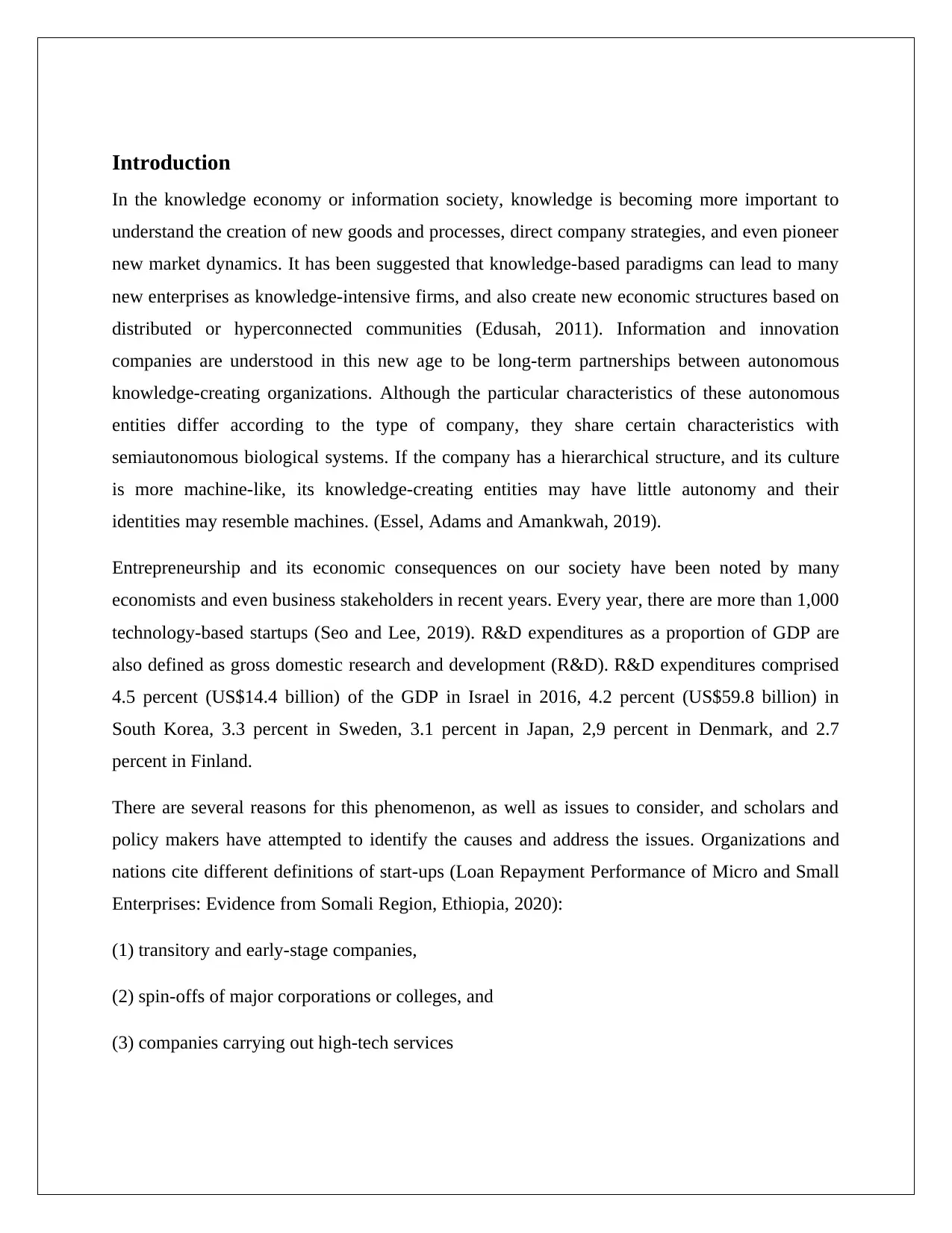
Introduction
In the knowledge economy or information society, knowledge is becoming more important to
understand the creation of new goods and processes, direct company strategies, and even pioneer
new market dynamics. It has been suggested that knowledge-based paradigms can lead to many
new enterprises as knowledge-intensive firms, and also create new economic structures based on
distributed or hyperconnected communities (Edusah, 2011). Information and innovation
companies are understood in this new age to be long-term partnerships between autonomous
knowledge-creating organizations. Although the particular characteristics of these autonomous
entities differ according to the type of company, they share certain characteristics with
semiautonomous biological systems. If the company has a hierarchical structure, and its culture
is more machine-like, its knowledge-creating entities may have little autonomy and their
identities may resemble machines. (Essel, Adams and Amankwah, 2019).
Entrepreneurship and its economic consequences on our society have been noted by many
economists and even business stakeholders in recent years. Every year, there are more than 1,000
technology-based startups (Seo and Lee, 2019). R&D expenditures as a proportion of GDP are
also defined as gross domestic research and development (R&D). R&D expenditures comprised
4.5 percent (US$14.4 billion) of the GDP in Israel in 2016, 4.2 percent (US$59.8 billion) in
South Korea, 3.3 percent in Sweden, 3.1 percent in Japan, 2,9 percent in Denmark, and 2.7
percent in Finland.
There are several reasons for this phenomenon, as well as issues to consider, and scholars and
policy makers have attempted to identify the causes and address the issues. Organizations and
nations cite different definitions of start-ups (Loan Repayment Performance of Micro and Small
Enterprises: Evidence from Somali Region, Ethiopia, 2020):
(1) transitory and early-stage companies,
(2) spin-offs of major corporations or colleges, and
(3) companies carrying out high-tech services
In the knowledge economy or information society, knowledge is becoming more important to
understand the creation of new goods and processes, direct company strategies, and even pioneer
new market dynamics. It has been suggested that knowledge-based paradigms can lead to many
new enterprises as knowledge-intensive firms, and also create new economic structures based on
distributed or hyperconnected communities (Edusah, 2011). Information and innovation
companies are understood in this new age to be long-term partnerships between autonomous
knowledge-creating organizations. Although the particular characteristics of these autonomous
entities differ according to the type of company, they share certain characteristics with
semiautonomous biological systems. If the company has a hierarchical structure, and its culture
is more machine-like, its knowledge-creating entities may have little autonomy and their
identities may resemble machines. (Essel, Adams and Amankwah, 2019).
Entrepreneurship and its economic consequences on our society have been noted by many
economists and even business stakeholders in recent years. Every year, there are more than 1,000
technology-based startups (Seo and Lee, 2019). R&D expenditures as a proportion of GDP are
also defined as gross domestic research and development (R&D). R&D expenditures comprised
4.5 percent (US$14.4 billion) of the GDP in Israel in 2016, 4.2 percent (US$59.8 billion) in
South Korea, 3.3 percent in Sweden, 3.1 percent in Japan, 2,9 percent in Denmark, and 2.7
percent in Finland.
There are several reasons for this phenomenon, as well as issues to consider, and scholars and
policy makers have attempted to identify the causes and address the issues. Organizations and
nations cite different definitions of start-ups (Loan Repayment Performance of Micro and Small
Enterprises: Evidence from Somali Region, Ethiopia, 2020):
(1) transitory and early-stage companies,
(2) spin-offs of major corporations or colleges, and
(3) companies carrying out high-tech services
⊘ This is a preview!⊘
Do you want full access?
Subscribe today to unlock all pages.

Trusted by 1+ million students worldwide
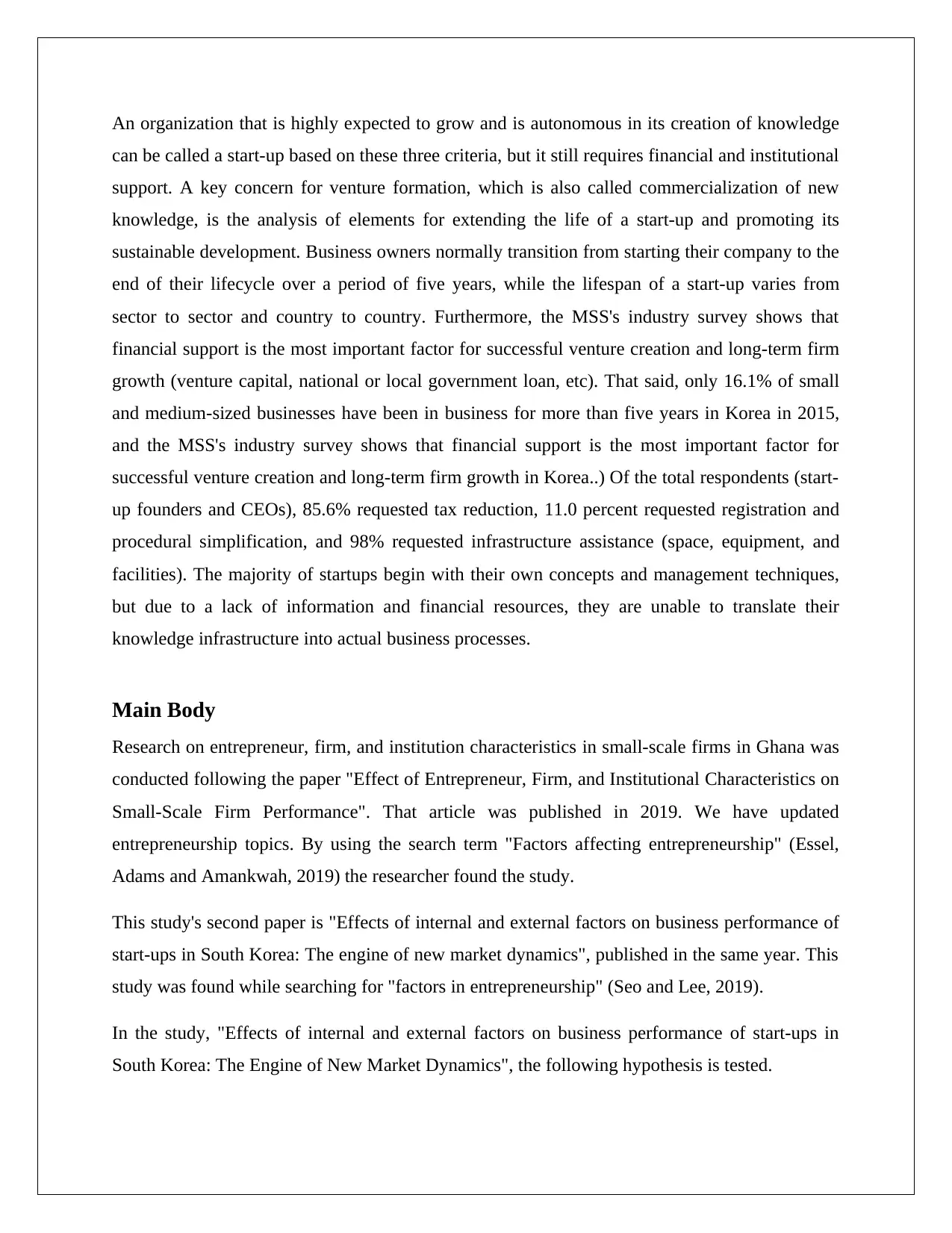
An organization that is highly expected to grow and is autonomous in its creation of knowledge
can be called a start-up based on these three criteria, but it still requires financial and institutional
support. A key concern for venture formation, which is also called commercialization of new
knowledge, is the analysis of elements for extending the life of a start-up and promoting its
sustainable development. Business owners normally transition from starting their company to the
end of their lifecycle over a period of five years, while the lifespan of a start-up varies from
sector to sector and country to country. Furthermore, the MSS's industry survey shows that
financial support is the most important factor for successful venture creation and long-term firm
growth (venture capital, national or local government loan, etc). That said, only 16.1% of small
and medium-sized businesses have been in business for more than five years in Korea in 2015,
and the MSS's industry survey shows that financial support is the most important factor for
successful venture creation and long-term firm growth in Korea..) Of the total respondents (start-
up founders and CEOs), 85.6% requested tax reduction, 11.0 percent requested registration and
procedural simplification, and 98% requested infrastructure assistance (space, equipment, and
facilities). The majority of startups begin with their own concepts and management techniques,
but due to a lack of information and financial resources, they are unable to translate their
knowledge infrastructure into actual business processes.
Main Body
Research on entrepreneur, firm, and institution characteristics in small-scale firms in Ghana was
conducted following the paper "Effect of Entrepreneur, Firm, and Institutional Characteristics on
Small-Scale Firm Performance". That article was published in 2019. We have updated
entrepreneurship topics. By using the search term "Factors affecting entrepreneurship" (Essel,
Adams and Amankwah, 2019) the researcher found the study.
This study's second paper is "Effects of internal and external factors on business performance of
start-ups in South Korea: The engine of new market dynamics", published in the same year. This
study was found while searching for "factors in entrepreneurship" (Seo and Lee, 2019).
In the study, "Effects of internal and external factors on business performance of start-ups in
South Korea: The Engine of New Market Dynamics", the following hypothesis is tested.
can be called a start-up based on these three criteria, but it still requires financial and institutional
support. A key concern for venture formation, which is also called commercialization of new
knowledge, is the analysis of elements for extending the life of a start-up and promoting its
sustainable development. Business owners normally transition from starting their company to the
end of their lifecycle over a period of five years, while the lifespan of a start-up varies from
sector to sector and country to country. Furthermore, the MSS's industry survey shows that
financial support is the most important factor for successful venture creation and long-term firm
growth (venture capital, national or local government loan, etc). That said, only 16.1% of small
and medium-sized businesses have been in business for more than five years in Korea in 2015,
and the MSS's industry survey shows that financial support is the most important factor for
successful venture creation and long-term firm growth in Korea..) Of the total respondents (start-
up founders and CEOs), 85.6% requested tax reduction, 11.0 percent requested registration and
procedural simplification, and 98% requested infrastructure assistance (space, equipment, and
facilities). The majority of startups begin with their own concepts and management techniques,
but due to a lack of information and financial resources, they are unable to translate their
knowledge infrastructure into actual business processes.
Main Body
Research on entrepreneur, firm, and institution characteristics in small-scale firms in Ghana was
conducted following the paper "Effect of Entrepreneur, Firm, and Institutional Characteristics on
Small-Scale Firm Performance". That article was published in 2019. We have updated
entrepreneurship topics. By using the search term "Factors affecting entrepreneurship" (Essel,
Adams and Amankwah, 2019) the researcher found the study.
This study's second paper is "Effects of internal and external factors on business performance of
start-ups in South Korea: The engine of new market dynamics", published in the same year. This
study was found while searching for "factors in entrepreneurship" (Seo and Lee, 2019).
In the study, "Effects of internal and external factors on business performance of start-ups in
South Korea: The Engine of New Market Dynamics", the following hypothesis is tested.
Paraphrase This Document
Need a fresh take? Get an instant paraphrase of this document with our AI Paraphraser
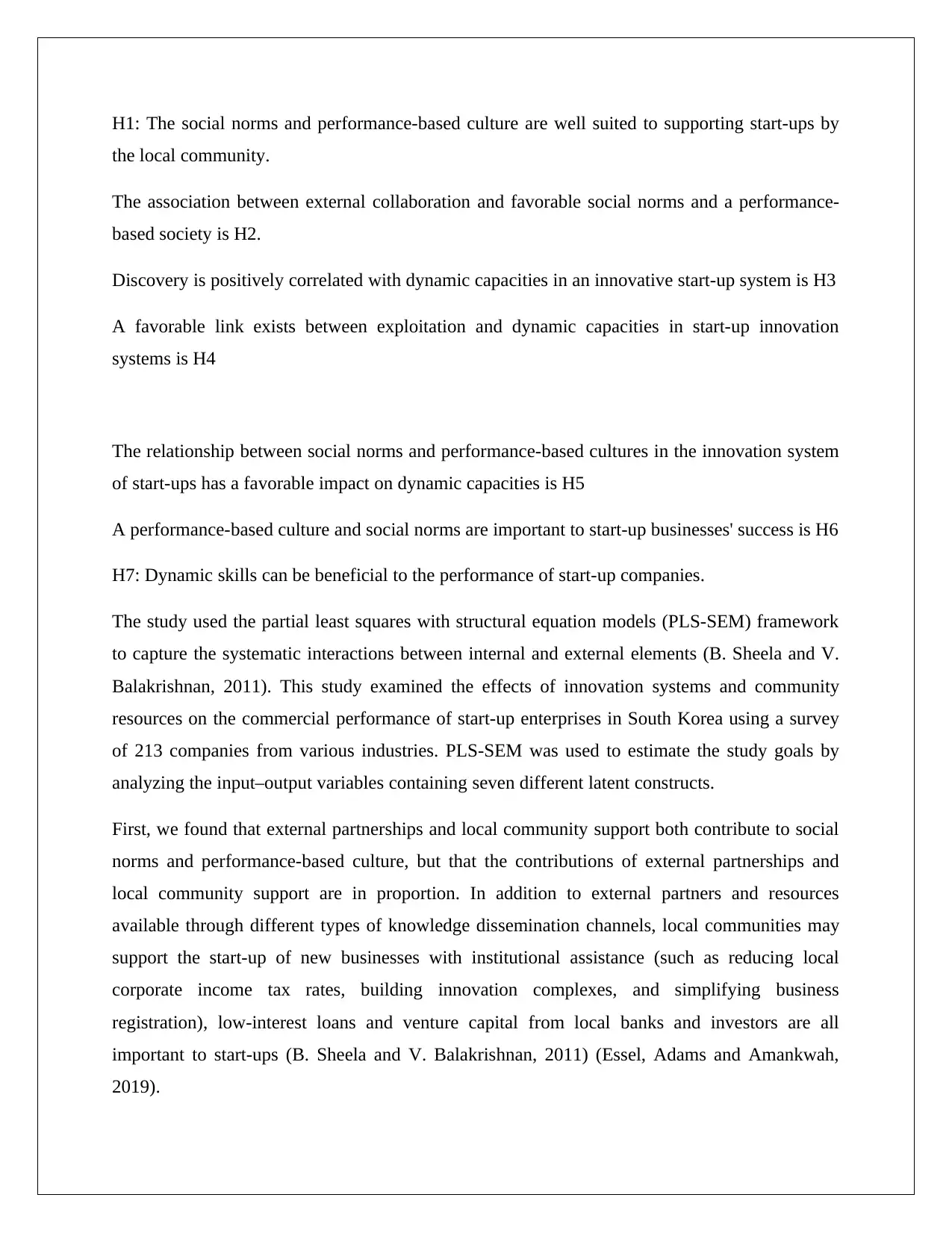
H1: The social norms and performance-based culture are well suited to supporting start-ups by
the local community.
The association between external collaboration and favorable social norms and a performance-
based society is H2.
Discovery is positively correlated with dynamic capacities in an innovative start-up system is H3
A favorable link exists between exploitation and dynamic capacities in start-up innovation
systems is H4
The relationship between social norms and performance-based cultures in the innovation system
of start-ups has a favorable impact on dynamic capacities is H5
A performance-based culture and social norms are important to start-up businesses' success is H6
H7: Dynamic skills can be beneficial to the performance of start-up companies.
The study used the partial least squares with structural equation models (PLS-SEM) framework
to capture the systematic interactions between internal and external elements (B. Sheela and V.
Balakrishnan, 2011). This study examined the effects of innovation systems and community
resources on the commercial performance of start-up enterprises in South Korea using a survey
of 213 companies from various industries. PLS-SEM was used to estimate the study goals by
analyzing the input–output variables containing seven different latent constructs.
First, we found that external partnerships and local community support both contribute to social
norms and performance-based culture, but that the contributions of external partnerships and
local community support are in proportion. In addition to external partners and resources
available through different types of knowledge dissemination channels, local communities may
support the start-up of new businesses with institutional assistance (such as reducing local
corporate income tax rates, building innovation complexes, and simplifying business
registration), low-interest loans and venture capital from local banks and investors are all
important to start-ups (B. Sheela and V. Balakrishnan, 2011) (Essel, Adams and Amankwah,
2019).
the local community.
The association between external collaboration and favorable social norms and a performance-
based society is H2.
Discovery is positively correlated with dynamic capacities in an innovative start-up system is H3
A favorable link exists between exploitation and dynamic capacities in start-up innovation
systems is H4
The relationship between social norms and performance-based cultures in the innovation system
of start-ups has a favorable impact on dynamic capacities is H5
A performance-based culture and social norms are important to start-up businesses' success is H6
H7: Dynamic skills can be beneficial to the performance of start-up companies.
The study used the partial least squares with structural equation models (PLS-SEM) framework
to capture the systematic interactions between internal and external elements (B. Sheela and V.
Balakrishnan, 2011). This study examined the effects of innovation systems and community
resources on the commercial performance of start-up enterprises in South Korea using a survey
of 213 companies from various industries. PLS-SEM was used to estimate the study goals by
analyzing the input–output variables containing seven different latent constructs.
First, we found that external partnerships and local community support both contribute to social
norms and performance-based culture, but that the contributions of external partnerships and
local community support are in proportion. In addition to external partners and resources
available through different types of knowledge dissemination channels, local communities may
support the start-up of new businesses with institutional assistance (such as reducing local
corporate income tax rates, building innovation complexes, and simplifying business
registration), low-interest loans and venture capital from local banks and investors are all
important to start-ups (B. Sheela and V. Balakrishnan, 2011) (Essel, Adams and Amankwah,
2019).
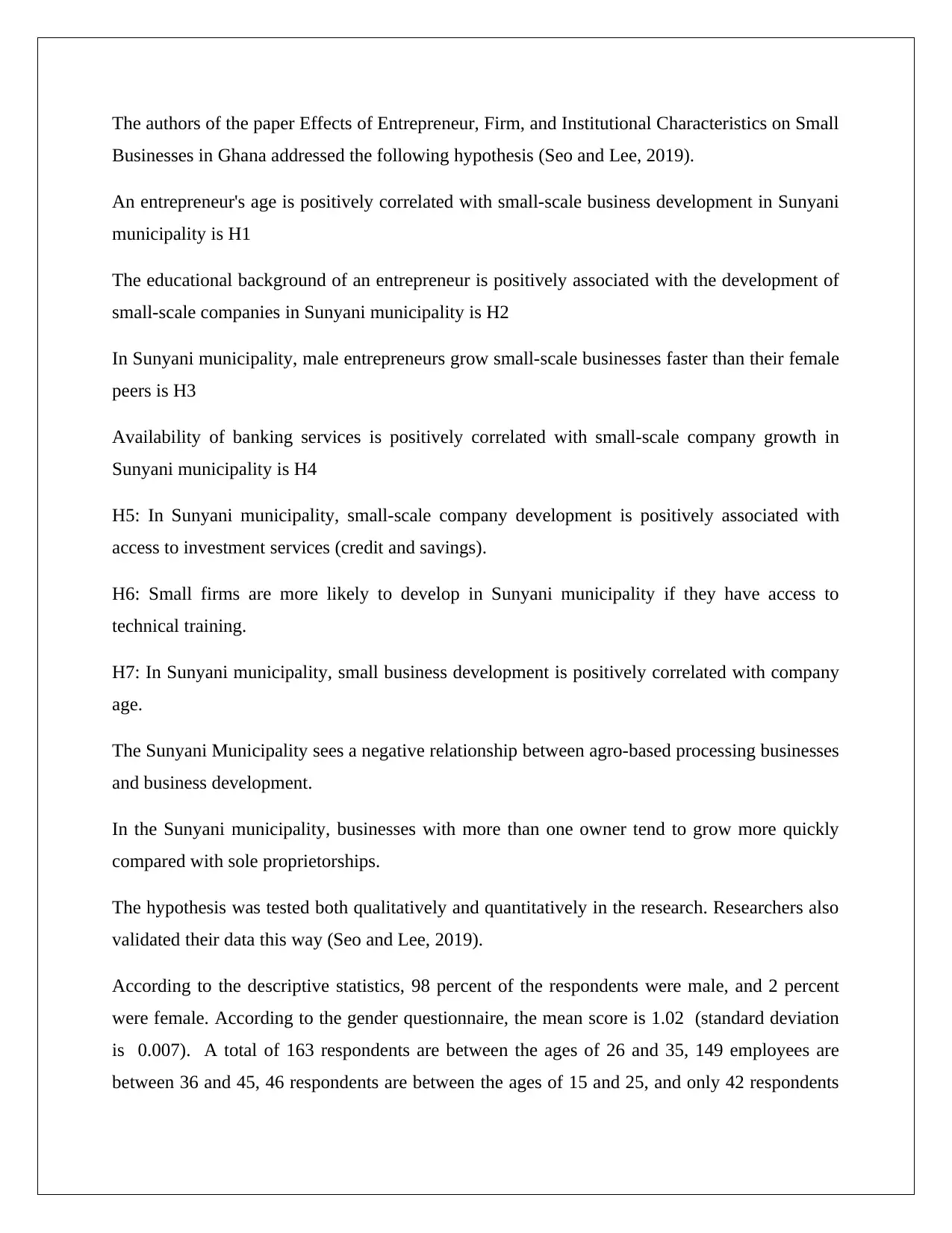
The authors of the paper Effects of Entrepreneur, Firm, and Institutional Characteristics on Small
Businesses in Ghana addressed the following hypothesis (Seo and Lee, 2019).
An entrepreneur's age is positively correlated with small-scale business development in Sunyani
municipality is H1
The educational background of an entrepreneur is positively associated with the development of
small-scale companies in Sunyani municipality is H2
In Sunyani municipality, male entrepreneurs grow small-scale businesses faster than their female
peers is H3
Availability of banking services is positively correlated with small-scale company growth in
Sunyani municipality is H4
H5: In Sunyani municipality, small-scale company development is positively associated with
access to investment services (credit and savings).
H6: Small firms are more likely to develop in Sunyani municipality if they have access to
technical training.
H7: In Sunyani municipality, small business development is positively correlated with company
age.
The Sunyani Municipality sees a negative relationship between agro-based processing businesses
and business development.
In the Sunyani municipality, businesses with more than one owner tend to grow more quickly
compared with sole proprietorships.
The hypothesis was tested both qualitatively and quantitatively in the research. Researchers also
validated their data this way (Seo and Lee, 2019).
According to the descriptive statistics, 98 percent of the respondents were male, and 2 percent
were female. According to the gender questionnaire, the mean score is 1.02 (standard deviation
is 0.007). A total of 163 respondents are between the ages of 26 and 35, 149 employees are
between 36 and 45, 46 respondents are between the ages of 15 and 25, and only 42 respondents
Businesses in Ghana addressed the following hypothesis (Seo and Lee, 2019).
An entrepreneur's age is positively correlated with small-scale business development in Sunyani
municipality is H1
The educational background of an entrepreneur is positively associated with the development of
small-scale companies in Sunyani municipality is H2
In Sunyani municipality, male entrepreneurs grow small-scale businesses faster than their female
peers is H3
Availability of banking services is positively correlated with small-scale company growth in
Sunyani municipality is H4
H5: In Sunyani municipality, small-scale company development is positively associated with
access to investment services (credit and savings).
H6: Small firms are more likely to develop in Sunyani municipality if they have access to
technical training.
H7: In Sunyani municipality, small business development is positively correlated with company
age.
The Sunyani Municipality sees a negative relationship between agro-based processing businesses
and business development.
In the Sunyani municipality, businesses with more than one owner tend to grow more quickly
compared with sole proprietorships.
The hypothesis was tested both qualitatively and quantitatively in the research. Researchers also
validated their data this way (Seo and Lee, 2019).
According to the descriptive statistics, 98 percent of the respondents were male, and 2 percent
were female. According to the gender questionnaire, the mean score is 1.02 (standard deviation
is 0.007). A total of 163 respondents are between the ages of 26 and 35, 149 employees are
between 36 and 45, 46 respondents are between the ages of 15 and 25, and only 42 respondents
⊘ This is a preview!⊘
Do you want full access?
Subscribe today to unlock all pages.

Trusted by 1+ million students worldwide
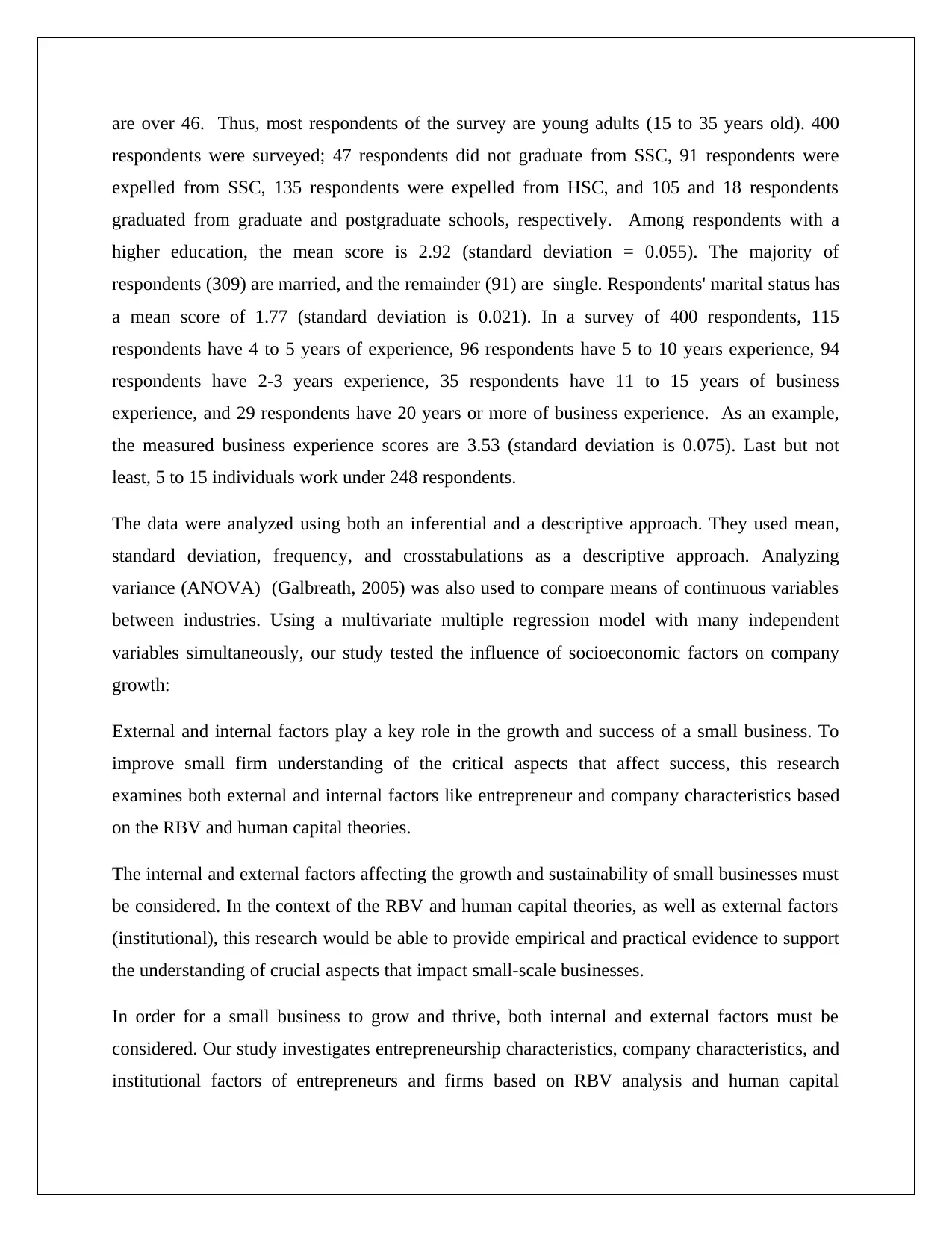
are over 46. Thus, most respondents of the survey are young adults (15 to 35 years old). 400
respondents were surveyed; 47 respondents did not graduate from SSC, 91 respondents were
expelled from SSC, 135 respondents were expelled from HSC, and 105 and 18 respondents
graduated from graduate and postgraduate schools, respectively. Among respondents with a
higher education, the mean score is 2.92 (standard deviation = 0.055). The majority of
respondents (309) are married, and the remainder (91) are single. Respondents' marital status has
a mean score of 1.77 (standard deviation is 0.021). In a survey of 400 respondents, 115
respondents have 4 to 5 years of experience, 96 respondents have 5 to 10 years experience, 94
respondents have 2-3 years experience, 35 respondents have 11 to 15 years of business
experience, and 29 respondents have 20 years or more of business experience. As an example,
the measured business experience scores are 3.53 (standard deviation is 0.075). Last but not
least, 5 to 15 individuals work under 248 respondents.
The data were analyzed using both an inferential and a descriptive approach. They used mean,
standard deviation, frequency, and crosstabulations as a descriptive approach. Analyzing
variance (ANOVA) (Galbreath, 2005) was also used to compare means of continuous variables
between industries. Using a multivariate multiple regression model with many independent
variables simultaneously, our study tested the influence of socioeconomic factors on company
growth:
External and internal factors play a key role in the growth and success of a small business. To
improve small firm understanding of the critical aspects that affect success, this research
examines both external and internal factors like entrepreneur and company characteristics based
on the RBV and human capital theories.
The internal and external factors affecting the growth and sustainability of small businesses must
be considered. In the context of the RBV and human capital theories, as well as external factors
(institutional), this research would be able to provide empirical and practical evidence to support
the understanding of crucial aspects that impact small-scale businesses.
In order for a small business to grow and thrive, both internal and external factors must be
considered. Our study investigates entrepreneurship characteristics, company characteristics, and
institutional factors of entrepreneurs and firms based on RBV analysis and human capital
respondents were surveyed; 47 respondents did not graduate from SSC, 91 respondents were
expelled from SSC, 135 respondents were expelled from HSC, and 105 and 18 respondents
graduated from graduate and postgraduate schools, respectively. Among respondents with a
higher education, the mean score is 2.92 (standard deviation = 0.055). The majority of
respondents (309) are married, and the remainder (91) are single. Respondents' marital status has
a mean score of 1.77 (standard deviation is 0.021). In a survey of 400 respondents, 115
respondents have 4 to 5 years of experience, 96 respondents have 5 to 10 years experience, 94
respondents have 2-3 years experience, 35 respondents have 11 to 15 years of business
experience, and 29 respondents have 20 years or more of business experience. As an example,
the measured business experience scores are 3.53 (standard deviation is 0.075). Last but not
least, 5 to 15 individuals work under 248 respondents.
The data were analyzed using both an inferential and a descriptive approach. They used mean,
standard deviation, frequency, and crosstabulations as a descriptive approach. Analyzing
variance (ANOVA) (Galbreath, 2005) was also used to compare means of continuous variables
between industries. Using a multivariate multiple regression model with many independent
variables simultaneously, our study tested the influence of socioeconomic factors on company
growth:
External and internal factors play a key role in the growth and success of a small business. To
improve small firm understanding of the critical aspects that affect success, this research
examines both external and internal factors like entrepreneur and company characteristics based
on the RBV and human capital theories.
The internal and external factors affecting the growth and sustainability of small businesses must
be considered. In the context of the RBV and human capital theories, as well as external factors
(institutional), this research would be able to provide empirical and practical evidence to support
the understanding of crucial aspects that impact small-scale businesses.
In order for a small business to grow and thrive, both internal and external factors must be
considered. Our study investigates entrepreneurship characteristics, company characteristics, and
institutional factors of entrepreneurs and firms based on RBV analysis and human capital
Paraphrase This Document
Need a fresh take? Get an instant paraphrase of this document with our AI Paraphraser
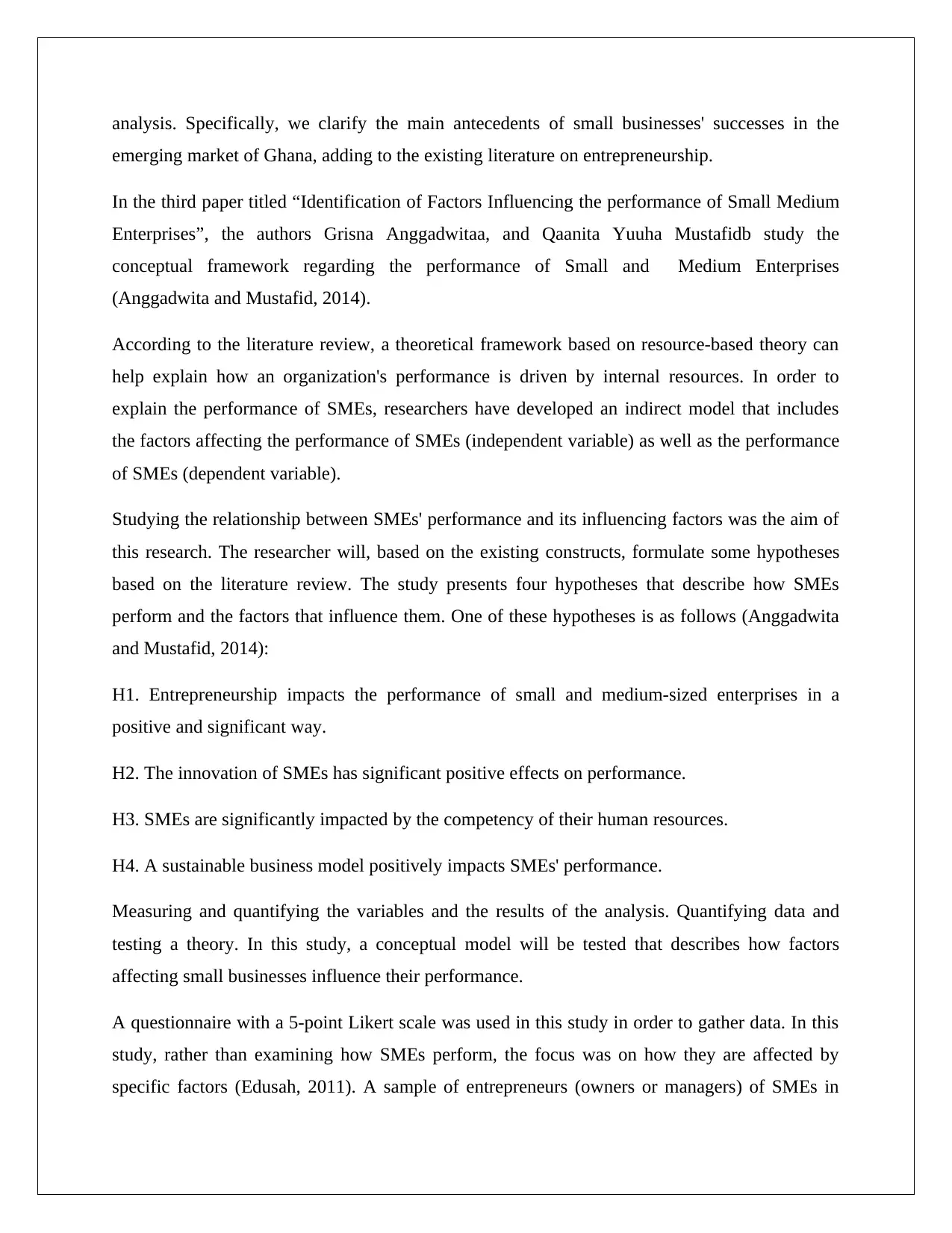
analysis. Specifically, we clarify the main antecedents of small businesses' successes in the
emerging market of Ghana, adding to the existing literature on entrepreneurship.
In the third paper titled “Identification of Factors Influencing the performance of Small Medium
Enterprises”, the authors Grisna Anggadwitaa, and Qaanita Yuuha Mustafidb study the
conceptual framework regarding the performance of Small and Medium Enterprises
(Anggadwita and Mustafid, 2014).
According to the literature review, a theoretical framework based on resource-based theory can
help explain how an organization's performance is driven by internal resources. In order to
explain the performance of SMEs, researchers have developed an indirect model that includes
the factors affecting the performance of SMEs (independent variable) as well as the performance
of SMEs (dependent variable).
Studying the relationship between SMEs' performance and its influencing factors was the aim of
this research. The researcher will, based on the existing constructs, formulate some hypotheses
based on the literature review. The study presents four hypotheses that describe how SMEs
perform and the factors that influence them. One of these hypotheses is as follows (Anggadwita
and Mustafid, 2014):
H1. Entrepreneurship impacts the performance of small and medium-sized enterprises in a
positive and significant way.
H2. The innovation of SMEs has significant positive effects on performance.
H3. SMEs are significantly impacted by the competency of their human resources.
H4. A sustainable business model positively impacts SMEs' performance.
Measuring and quantifying the variables and the results of the analysis. Quantifying data and
testing a theory. In this study, a conceptual model will be tested that describes how factors
affecting small businesses influence their performance.
A questionnaire with a 5-point Likert scale was used in this study in order to gather data. In this
study, rather than examining how SMEs perform, the focus was on how they are affected by
specific factors (Edusah, 2011). A sample of entrepreneurs (owners or managers) of SMEs in
emerging market of Ghana, adding to the existing literature on entrepreneurship.
In the third paper titled “Identification of Factors Influencing the performance of Small Medium
Enterprises”, the authors Grisna Anggadwitaa, and Qaanita Yuuha Mustafidb study the
conceptual framework regarding the performance of Small and Medium Enterprises
(Anggadwita and Mustafid, 2014).
According to the literature review, a theoretical framework based on resource-based theory can
help explain how an organization's performance is driven by internal resources. In order to
explain the performance of SMEs, researchers have developed an indirect model that includes
the factors affecting the performance of SMEs (independent variable) as well as the performance
of SMEs (dependent variable).
Studying the relationship between SMEs' performance and its influencing factors was the aim of
this research. The researcher will, based on the existing constructs, formulate some hypotheses
based on the literature review. The study presents four hypotheses that describe how SMEs
perform and the factors that influence them. One of these hypotheses is as follows (Anggadwita
and Mustafid, 2014):
H1. Entrepreneurship impacts the performance of small and medium-sized enterprises in a
positive and significant way.
H2. The innovation of SMEs has significant positive effects on performance.
H3. SMEs are significantly impacted by the competency of their human resources.
H4. A sustainable business model positively impacts SMEs' performance.
Measuring and quantifying the variables and the results of the analysis. Quantifying data and
testing a theory. In this study, a conceptual model will be tested that describes how factors
affecting small businesses influence their performance.
A questionnaire with a 5-point Likert scale was used in this study in order to gather data. In this
study, rather than examining how SMEs perform, the focus was on how they are affected by
specific factors (Edusah, 2011). A sample of entrepreneurs (owners or managers) of SMEs in
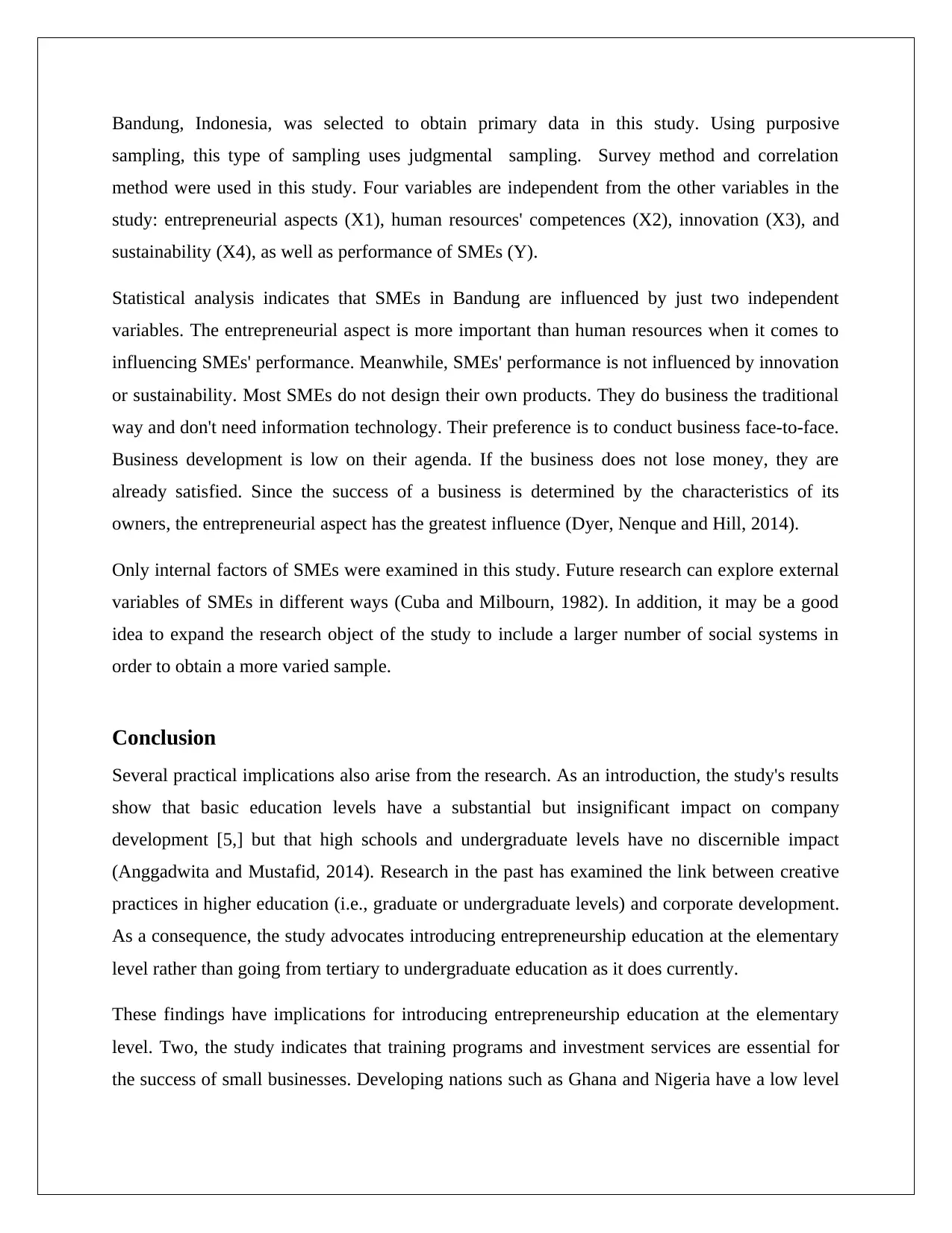
Bandung, Indonesia, was selected to obtain primary data in this study. Using purposive
sampling, this type of sampling uses judgmental sampling. Survey method and correlation
method were used in this study. Four variables are independent from the other variables in the
study: entrepreneurial aspects (X1), human resources' competences (X2), innovation (X3), and
sustainability (X4), as well as performance of SMEs (Y).
Statistical analysis indicates that SMEs in Bandung are influenced by just two independent
variables. The entrepreneurial aspect is more important than human resources when it comes to
influencing SMEs' performance. Meanwhile, SMEs' performance is not influenced by innovation
or sustainability. Most SMEs do not design their own products. They do business the traditional
way and don't need information technology. Their preference is to conduct business face-to-face.
Business development is low on their agenda. If the business does not lose money, they are
already satisfied. Since the success of a business is determined by the characteristics of its
owners, the entrepreneurial aspect has the greatest influence (Dyer, Nenque and Hill, 2014).
Only internal factors of SMEs were examined in this study. Future research can explore external
variables of SMEs in different ways (Cuba and Milbourn, 1982). In addition, it may be a good
idea to expand the research object of the study to include a larger number of social systems in
order to obtain a more varied sample.
Conclusion
Several practical implications also arise from the research. As an introduction, the study's results
show that basic education levels have a substantial but insignificant impact on company
development [5,] but that high schools and undergraduate levels have no discernible impact
(Anggadwita and Mustafid, 2014). Research in the past has examined the link between creative
practices in higher education (i.e., graduate or undergraduate levels) and corporate development.
As a consequence, the study advocates introducing entrepreneurship education at the elementary
level rather than going from tertiary to undergraduate education as it does currently.
These findings have implications for introducing entrepreneurship education at the elementary
level. Two, the study indicates that training programs and investment services are essential for
the success of small businesses. Developing nations such as Ghana and Nigeria have a low level
sampling, this type of sampling uses judgmental sampling. Survey method and correlation
method were used in this study. Four variables are independent from the other variables in the
study: entrepreneurial aspects (X1), human resources' competences (X2), innovation (X3), and
sustainability (X4), as well as performance of SMEs (Y).
Statistical analysis indicates that SMEs in Bandung are influenced by just two independent
variables. The entrepreneurial aspect is more important than human resources when it comes to
influencing SMEs' performance. Meanwhile, SMEs' performance is not influenced by innovation
or sustainability. Most SMEs do not design their own products. They do business the traditional
way and don't need information technology. Their preference is to conduct business face-to-face.
Business development is low on their agenda. If the business does not lose money, they are
already satisfied. Since the success of a business is determined by the characteristics of its
owners, the entrepreneurial aspect has the greatest influence (Dyer, Nenque and Hill, 2014).
Only internal factors of SMEs were examined in this study. Future research can explore external
variables of SMEs in different ways (Cuba and Milbourn, 1982). In addition, it may be a good
idea to expand the research object of the study to include a larger number of social systems in
order to obtain a more varied sample.
Conclusion
Several practical implications also arise from the research. As an introduction, the study's results
show that basic education levels have a substantial but insignificant impact on company
development [5,] but that high schools and undergraduate levels have no discernible impact
(Anggadwita and Mustafid, 2014). Research in the past has examined the link between creative
practices in higher education (i.e., graduate or undergraduate levels) and corporate development.
As a consequence, the study advocates introducing entrepreneurship education at the elementary
level rather than going from tertiary to undergraduate education as it does currently.
These findings have implications for introducing entrepreneurship education at the elementary
level. Two, the study indicates that training programs and investment services are essential for
the success of small businesses. Developing nations such as Ghana and Nigeria have a low level
⊘ This is a preview!⊘
Do you want full access?
Subscribe today to unlock all pages.

Trusted by 1+ million students worldwide
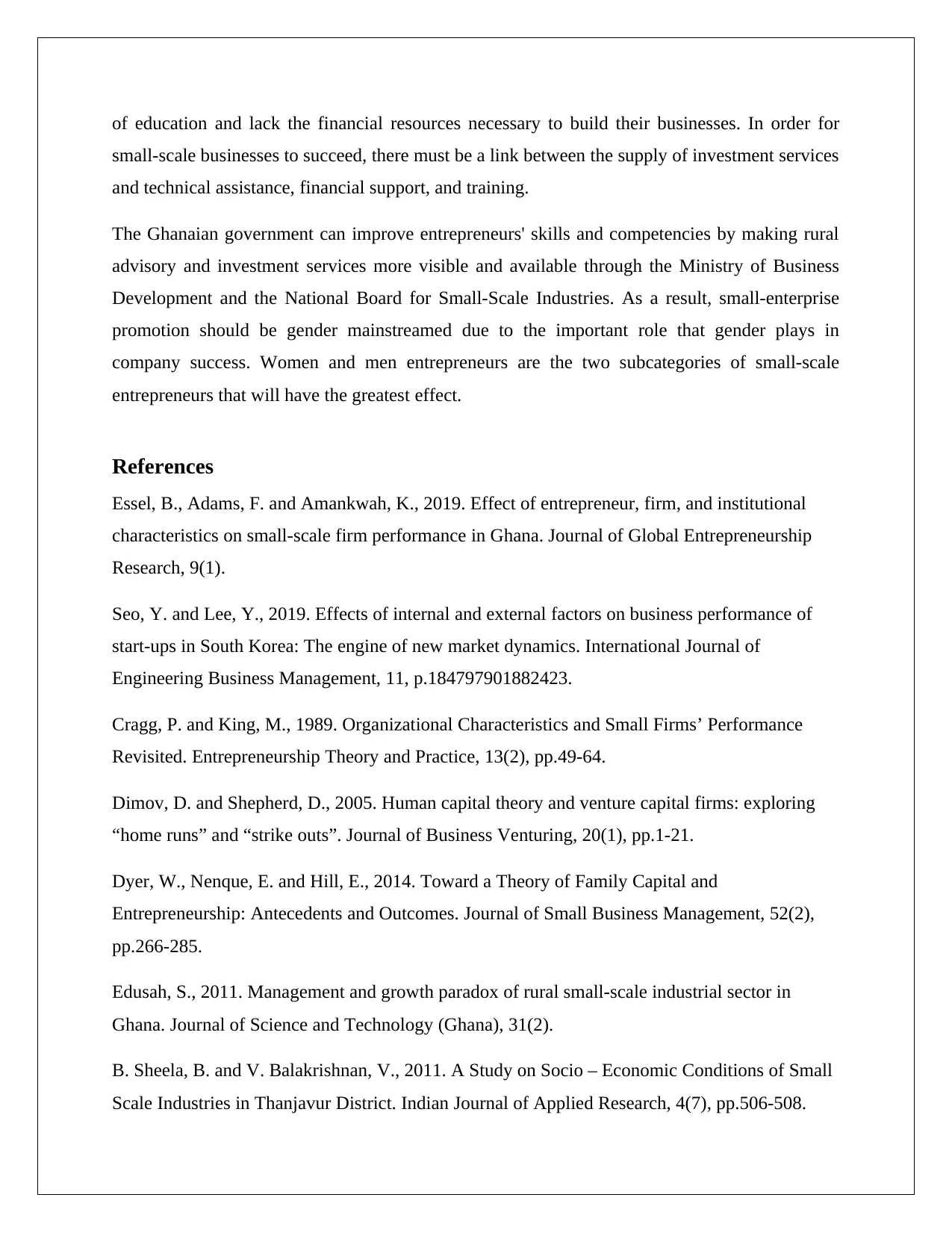
of education and lack the financial resources necessary to build their businesses. In order for
small-scale businesses to succeed, there must be a link between the supply of investment services
and technical assistance, financial support, and training.
The Ghanaian government can improve entrepreneurs' skills and competencies by making rural
advisory and investment services more visible and available through the Ministry of Business
Development and the National Board for Small-Scale Industries. As a result, small-enterprise
promotion should be gender mainstreamed due to the important role that gender plays in
company success. Women and men entrepreneurs are the two subcategories of small-scale
entrepreneurs that will have the greatest effect.
References
Essel, B., Adams, F. and Amankwah, K., 2019. Effect of entrepreneur, firm, and institutional
characteristics on small-scale firm performance in Ghana. Journal of Global Entrepreneurship
Research, 9(1).
Seo, Y. and Lee, Y., 2019. Effects of internal and external factors on business performance of
start-ups in South Korea: The engine of new market dynamics. International Journal of
Engineering Business Management, 11, p.184797901882423.
Cragg, P. and King, M., 1989. Organizational Characteristics and Small Firms’ Performance
Revisited. Entrepreneurship Theory and Practice, 13(2), pp.49-64.
Dimov, D. and Shepherd, D., 2005. Human capital theory and venture capital firms: exploring
“home runs” and “strike outs”. Journal of Business Venturing, 20(1), pp.1-21.
Dyer, W., Nenque, E. and Hill, E., 2014. Toward a Theory of Family Capital and
Entrepreneurship: Antecedents and Outcomes. Journal of Small Business Management, 52(2),
pp.266-285.
Edusah, S., 2011. Management and growth paradox of rural small-scale industrial sector in
Ghana. Journal of Science and Technology (Ghana), 31(2).
B. Sheela, B. and V. Balakrishnan, V., 2011. A Study on Socio – Economic Conditions of Small
Scale Industries in Thanjavur District. Indian Journal of Applied Research, 4(7), pp.506-508.
small-scale businesses to succeed, there must be a link between the supply of investment services
and technical assistance, financial support, and training.
The Ghanaian government can improve entrepreneurs' skills and competencies by making rural
advisory and investment services more visible and available through the Ministry of Business
Development and the National Board for Small-Scale Industries. As a result, small-enterprise
promotion should be gender mainstreamed due to the important role that gender plays in
company success. Women and men entrepreneurs are the two subcategories of small-scale
entrepreneurs that will have the greatest effect.
References
Essel, B., Adams, F. and Amankwah, K., 2019. Effect of entrepreneur, firm, and institutional
characteristics on small-scale firm performance in Ghana. Journal of Global Entrepreneurship
Research, 9(1).
Seo, Y. and Lee, Y., 2019. Effects of internal and external factors on business performance of
start-ups in South Korea: The engine of new market dynamics. International Journal of
Engineering Business Management, 11, p.184797901882423.
Cragg, P. and King, M., 1989. Organizational Characteristics and Small Firms’ Performance
Revisited. Entrepreneurship Theory and Practice, 13(2), pp.49-64.
Dimov, D. and Shepherd, D., 2005. Human capital theory and venture capital firms: exploring
“home runs” and “strike outs”. Journal of Business Venturing, 20(1), pp.1-21.
Dyer, W., Nenque, E. and Hill, E., 2014. Toward a Theory of Family Capital and
Entrepreneurship: Antecedents and Outcomes. Journal of Small Business Management, 52(2),
pp.266-285.
Edusah, S., 2011. Management and growth paradox of rural small-scale industrial sector in
Ghana. Journal of Science and Technology (Ghana), 31(2).
B. Sheela, B. and V. Balakrishnan, V., 2011. A Study on Socio – Economic Conditions of Small
Scale Industries in Thanjavur District. Indian Journal of Applied Research, 4(7), pp.506-508.
Paraphrase This Document
Need a fresh take? Get an instant paraphrase of this document with our AI Paraphraser
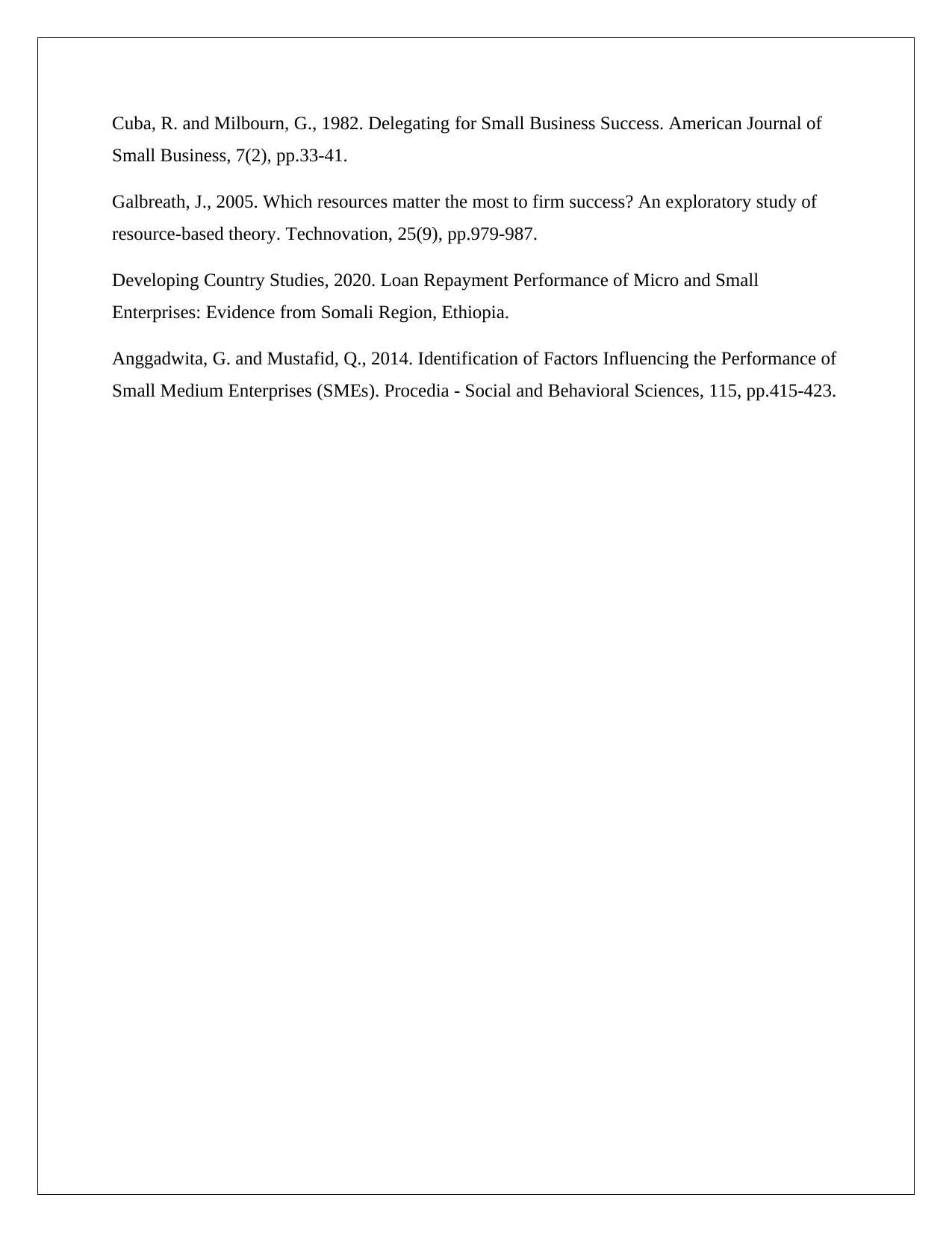
Cuba, R. and Milbourn, G., 1982. Delegating for Small Business Success. American Journal of
Small Business, 7(2), pp.33-41.
Galbreath, J., 2005. Which resources matter the most to firm success? An exploratory study of
resource-based theory. Technovation, 25(9), pp.979-987.
Developing Country Studies, 2020. Loan Repayment Performance of Micro and Small
Enterprises: Evidence from Somali Region, Ethiopia.
Anggadwita, G. and Mustafid, Q., 2014. Identification of Factors Influencing the Performance of
Small Medium Enterprises (SMEs). Procedia - Social and Behavioral Sciences, 115, pp.415-423.
Small Business, 7(2), pp.33-41.
Galbreath, J., 2005. Which resources matter the most to firm success? An exploratory study of
resource-based theory. Technovation, 25(9), pp.979-987.
Developing Country Studies, 2020. Loan Repayment Performance of Micro and Small
Enterprises: Evidence from Somali Region, Ethiopia.
Anggadwita, G. and Mustafid, Q., 2014. Identification of Factors Influencing the Performance of
Small Medium Enterprises (SMEs). Procedia - Social and Behavioral Sciences, 115, pp.415-423.
1 out of 11
Related Documents
Your All-in-One AI-Powered Toolkit for Academic Success.
+13062052269
info@desklib.com
Available 24*7 on WhatsApp / Email
![[object Object]](/_next/static/media/star-bottom.7253800d.svg)
Unlock your academic potential
Copyright © 2020–2025 A2Z Services. All Rights Reserved. Developed and managed by ZUCOL.




